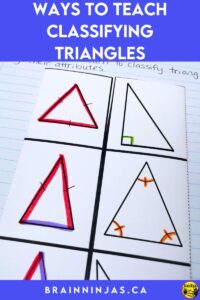
Triangles are fundamental shapes in your geometry lessons. Understanding their properties lays a strong foundation for further mathematical learning. Students need to understand measurements of side lengths and angles to classify triangles. Come learn some of the ways to teach classifying triangles in your upper elementary classroom.
What is a Triangle?
Before diving into the different types of triangles, it’s essential to establish a clear understanding of a triangle. A triangle is a polygon (an enclosed shape with straight sides) with three sides and three angles. Each angle of a triangle adds up to 180 degrees, making it a closed figure.
What are the Different Types of Triangles?
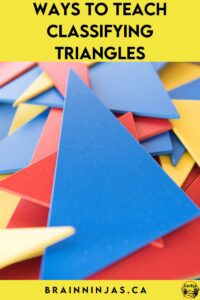
Triangles are named by their side lengths or their angles. This means all triangles can technically have two names. When you’re teaching classifying triangles, it is important to be clear with students about which name you are looking for.
Classifying Triangles by Side Lengths
An equilateral triangle has three equal sides and three equal angles. Each of the three angles measures 60 degrees.
An isosceles triangle has two equal sides and two equal angles.
A scalene triangle has three unequal sides and three unequal angles.
Classifying Triangles by Angles
A right triangle has one right angle (90 degrees). The side opposite the right angle is called the hypotenuse.
An acute triangle means that all the angles measure less than 90 degrees.
An obtuse triangle has one angle measuring more than 90 degrees. It is not possible to have more than one angle that is 90 degrees because there are only 180 degrees inside a triangle.
Ways to Teach Classifying Triangles
Explicitly Teach Classifying Triangles
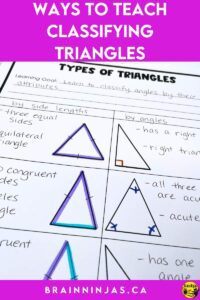
We include a lesson to learn the types of triangles and how to classify them in our Interactive Math Units. Our math units come with complete lessons, options for differentiation, background information for the teacher, student templates, worksheets, games or activities to reinforce concepts and assessments. We’ve aligned our math units to the new Alberta Mathematics Curriculum, British Columbia Curricular Competencies and Saskatchewan Math Curriculum.
The Geometry Interactive Math Unit for Grade 4 is available on TpT ($USD) and our BN Shop ($CAN).
Geometry Interactive Math Unit for Grade 4/5 is available on TpT ($USD) and our BN Shop ($CAN). This is designed for combined classrooms.
Geometry Interactive Math Unit for Grade 5 is available on TpT ($USD) and our BN Shop ($CAN).
Our Geometry Interactive Math Unit for Grade 5/6 is available on TpT ($USD) and our BN Shop ($CAN). This is designed for combined classrooms.
Geometry Interactive Math Unit for Grade 6 is available on TpT ($USD) and our BN Shop ($CAN).
Hands-On Exploration
Provide students with cut-out triangles of different types (equilateral, isosceles, scalene) made from construction paper. If you have polygon manipulatives, these work, too. Up the student engagement by having students make and cut out the triangles themselves. It doesn’t matter what types of triangles students make, because the work comes with the classifying.
Have students classify and sort the triangles into their respective types based on side lengths and angle measurements.
Encourage students to measure the sides and angles of each triangle using protractors and rulers.
Triangle Hunting
Ask students to find each of the different types of triangles on the walls of your classroom or outside on the playground (there are lots of great shapes out there). They should use a ruler and protractor to make sure the measurements are accurate.
Videos about Classifying Triangles

Numberock has a naming triangles video you can watch here on YouTube. It’s a catchy song that will get stuck in your head.
Smile and Learn has a simple video available on YouTube here.
As usual, Mathantics has a great video with lots of great vocabulary. You can watch it on YouTube here.
Khan Academy has lessons and practice activities on its site. This is the link to the triangles lessons.
Practice, Review or Assess Classifying Triangles
Worksheets
We have created sets of worksheets for students to use to practice. Our worksheet sets do not include lessons, but some of the pages have illustrated examples. If you’re looking to take worksheets to the next level by turning them into engaging games, check out our post Math Worksheet Games Your Students Will Love.
- Types of Triangles (introduction to triangles) can be found on TpT ($USD) and in our BN Shop ($CAN).
- Find Types of Triangles on TpT ($USD) and in our BN Shop ($CAN).
- Types of Triangles (more complex questions) can be found on TpT ($USD) and in our BN Shop ($CAN).
If you have also taught finding the area of triangles, we have a set for that. Find Area of Triangles on TpT ($USD) and in our BN Shop ($CAN).
Collaborative Projects
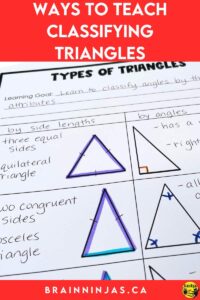
Assign group projects where students create posters or presentations showcasing various types of triangles found in everyday objects, architecture, or nature. Encourage creativity by allowing students to use multimedia elements like photographs, drawings, and digital images to illustrate their findings. Students can present these in a simple slide show to demonstrate what they’ve learned.
If students cannot go out into the world to find the triangles, use images they find online. Have students use tools like text boxes and arrows to label the triangles in the images. Remind students to look at bridges. Triangles are a very strong shape used in a lot of bridge construction.
Triangle Art
Create a simple art project that uses triangles. Have students draw lines over their page to make a variety of triangles only. The challenge is not to make any other shapes. Colour in the triangles. Add a layer of math by having students label the triangles.
Make a Triangle Table
Use masking tape on the surface of a desk or table to make a variety of triangles. Have students use rulers or protractors to measure and classify the triangles.
Are You Teaching Geometry?
We created this simple set of Geometry Task Cards that uses a variety of geometry concepts. The set can be used with paper (by printing), Google Slides or Google Forms (which can mark it for you). You can find the Geometry Task Cards in the Resource Library. If you’re not already a ninja, we can send it directly to your inbox when you sign up for our email list.
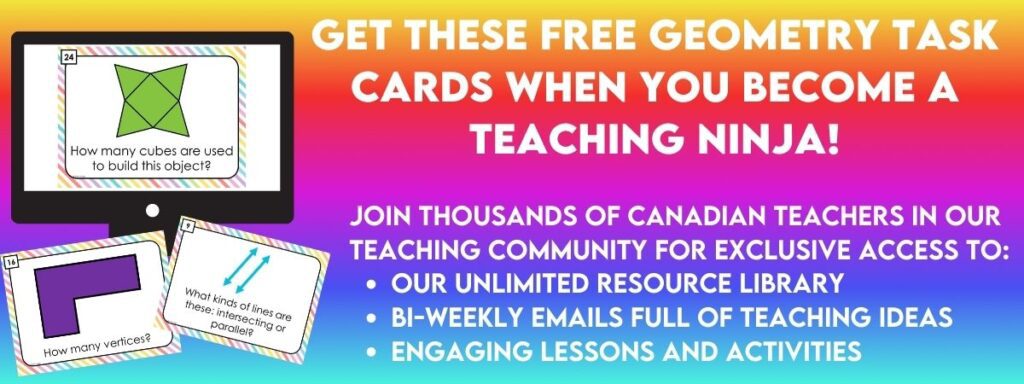
Do You Teach Math?
- How to Unfold Geometry: Books to Shape Your Unit
- How to Help Your Students Master Decimal Operations
- 7 Ways to Upgrade Your Fraction Strategies
- How to Demystify Math With These 7 Algebra Activities
- Conquer Math With These Proven Multiplication Strategies
- How to Make Teaching Patterns Painless
- Amazing Measurement Activities to Stretch Math
- How to Teach Students to Tell Time
- How to Teach Successful Long Division Strategies
- Ways to Bring Graphing Activities into Your Classroom Daily
- Mastering the Angles: Innovative Approaches to Teaching Geometry Concepts
- How to Teach Rounding Numbers
What Else?
What other ways do you teach classifying triangles? We’d love to hear about it in the comments below.






